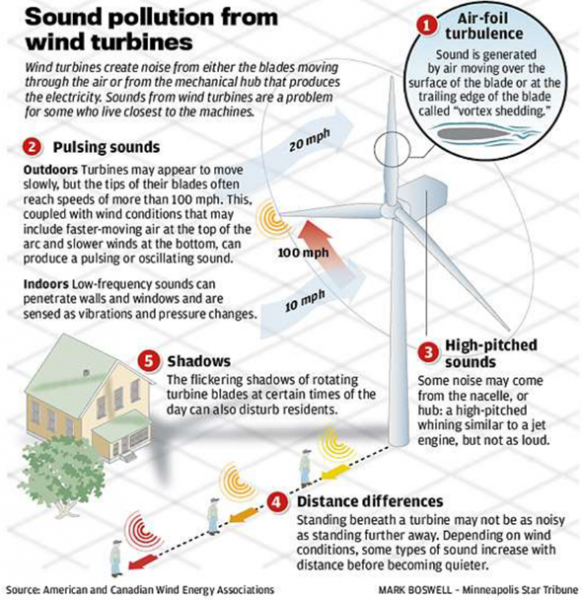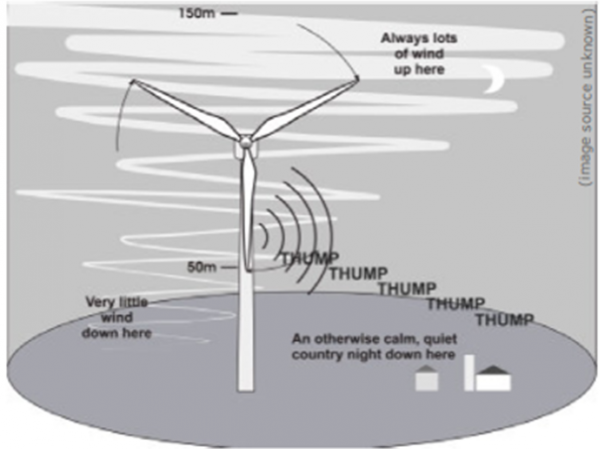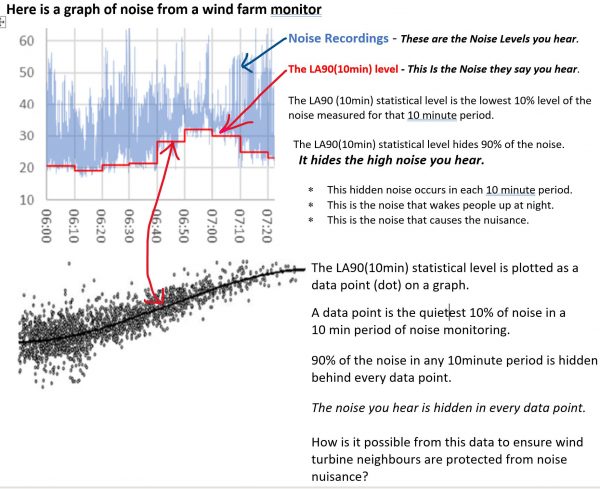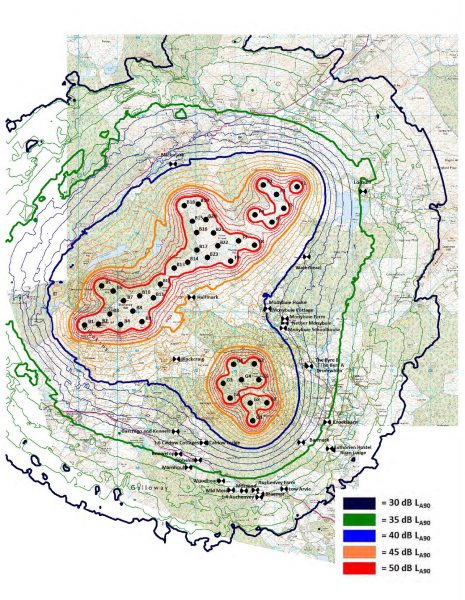Acoustic pollution
For help with Wind Turbine Noise Issues in Scotland and the UK:
contact@citizensinitiativeuk.org.uk
grosvenorconsultancy@gmail.com
(Extracts from Educating Lawyers series by Viv-Alyn Lenehan, transposed here to ETSU R 97, from the New Zealand Standards (NZS 1998 or 2010)
These notes and papers are as a result of the Bald Hills Judgement:
JUDGE: Richards J. Dates: 6–10, 13–17, 20–23 September, 12 October 2021. date of judgment: 25 March 2022 cited as: Uren v Bald Hills Wind Farm Pty ltd. Medium neutral citation: [2022] VSC 145
The judgement can be found here
- Apart from the obvious precedent set by a couple of Aussie blokes who took on a wind farm in court and won, lawyers now have a clear game plan to follow when representing their clients in a wind farm noise litigation case. The Bald Hills Precedent
- Turbines noise, vibrations and infrasonic pulsations cause turbine sickness and sleep disturbance.
See the figure below illustrating sound pollution from wind turbines

2. Turbines are alien to a rural environment.
Turbines are distinctively noisy in rural areas, particularly during certain times of the year when the atmospheric conditions increase noise transfer. In the Bald Hills case, The Bald Hills Judge did not consider the industrial wind development as one of the established uses in the locality.
“The locality is rural, relatively quiet, and remote….…… The rural activities of stock grazing and farm activities do not cause intrusive noise at night”
The grinding sounds of the gear boxes adjusting the blade angles, and the screeching of the brakes controlling the yaw, wake people up at night – And people often can’t get back to sleep. Even when the blades are not moving, the fans in the turbines cooling the equipment in the nacelle continue to produce an annoying humming noise.
In some bedrooms the humming is amplified by room resonances.
Turbines also vibrate in the ground. The long blades leveraged off the towers cause the towers to vibrate and shudder. The propagation of vibration is dependent on the geology of the area.
These vibrations can be transmitted through the ground to the houses, up through the foundations, walls, and floors, into the bedroom and through the pillows.
The problems with Wind Turbines

3. ETSU R 97 is not written to readily identify short periods of noise nuisance that may impact sleep.
Demonstration of compliance does not necessarily establish that noise from time to time does not cause a nuisance. ETSU assumes wind farm noise is constant – it is not – it is intermittent.
From a distance, smaller turbines were heard as a constant low hum, like the hum of road traffic noise from a distant highway. Now modern turbines are six times the size and located at distances of only 1-2 kms from homes.
The LA90 statistical calculation is used in ETSU-R-97 as a proxy that minimises short term noise events from certain types of extraneous noise such as bird song or occasional passing local traffic but assumes that wind turbine operational noise is constant. Unfortunately, wind turbine noise from a wind farm is not constant.
ETSU was not written to analyse intermittent noise or noise on individual nights. This is due in part by the use of LA90 and in part by the use of averaging through trend analysis of scatter charts covering survey periods of weeks that averages out high impact periods on particular days or nights. Intermittent noise on individual nights is a major cause of nuisance.
Why the NZS has set Wind Farms up to Fail

4. Bullseye Noise Prediction Maps are based on FALSE ASSUMPTIONS
Contour maps represent LAeq values not LA90 values. However, the LAeq values are predicted based upon test results data from single wind turbines in idealised operating conditions and do not consider site effects or the influence on increased noise emissions due to wake turbulence from neighbouring wind turbines. Furthermore, predicted contour sound levels are derived from optimistic inputs into noise modelling software.
Bullseye maps are used to pacify neighbours. Conditions are set and wind turbines are built on this false theory. When the noise predictions are wrong – it’s too late, the turbines are up, and the noise nuisance starts.
5. Designed to deceive
The contour lines in the diagram below are NOT maximum levels of noise wind power plant neighbours will experience.

Intermittent noise is not shown in the contour maps. It is recognised that amplitude modulation, for example, cannot be reliably predicted so these contour charts do not indicate how much amplitude modulation will be experienced by neighbours.
Predictions are LAeq, not LA90 on the assumption that the noise from a wind farm is constant. In reality this is not the case and the LA90 proxy to relate to LAeq does not account for intermittent noise events such as when a wind turbine rotates with different incoming wind directions. Such intermittent sounds are not a part of the noise models used to generate the noise contour maps.
- Living on a 40dB contour line, a neighbour may hear noise levels of 41dB – 60dB (and even higher) at times that is not accounted for when using the LA90 measurement over 10-minute periods.
- There is no maximum limit for short duration sounds from wind turbines.
- 40 dB is the lowest optimistic constant noise level they will hear.
- 40dB can be exceeded from short term noise events that can occur for 90% of the time.
- For a 10 hour period of sleeping, 9 hours of noise will be above the 40dB level and only 1 hour of noise will be below 40dB.
- The high spikes of noise are NOT recognised in a LA90 statistical calculation.
- There is no maximum limit of noise for any contour line.
6. Bullseye maps are based on the false assumption that noise radiates out like a light bulb.
- How noise is propagated is very dependent on wind speed, direction, topography and the layout of adjacent turbines.
- Noise from turbines has direction like a TORCH BEAM. It does NOT spread out like a radiating sphere (light bulb) around the point source (turbine).
- The noise contour levels relate to the minimum noise and do not identify the variation in the noise levels or make correction for airflow disturbance and directivity of the sound patters.
- The torch beam noise pattern and levels of the pulsations are dramatically affected with changes in wind speed and direction.
7.Turbine sickness
Turbine sickness, like sea sickness and motion sickness, is caused by unnatural periodic movements or pressures on the body which trigger an autonomic stress reaction in the body leading to physical illness. Turbine Sickness
The Common Law of noise nuisance is argued on evidence. A lawyer requires evidence to make a case.
The Bald Hills precedent determined that authentic and genuine subjective evidence is tenable in court. Collecting the Evidence
8. Further original Educating Lawyers series (they may not be applicable in the UK):
The Wind Industry is unregulated.
No authority requires wind farms to disclose the technical data behind their reports.
Wind farm acousticians can lie and cheat and fabricate the results and nobody knows.
A wind farm will always promise you a “noise report”. They do this to pacify you.
A wind farm Noise Report does NOT contain Raw Data. Without Raw Data the Noise Report is a Lie
Why Wind Farms are Exposed to Litigation
The EPA must protect you from noise harm
Educating the Lawyers – So What Now

 European Platform Against Windfarms
European Platform Against Windfarms